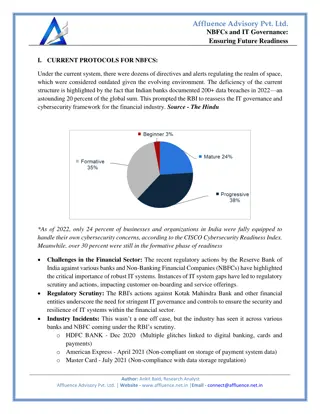
Paytm's journey from a market leading player India to a follower of its competitors
Paytm's journey is a compelling tale of innovation, ambition, and the challenges that come with rapid growth. Once a frontrunner in India's digital payments landscape, it now finds itself navigating turbulent waters as competitors surge ahead. The in
Download Presentation

Please find below an Image/Link to download the presentation.
The content on the website is provided AS IS for your information and personal use only. It may not be sold, licensed, or shared on other websites without obtaining consent from the author. If you encounter any issues during the download, it is possible that the publisher has removed the file from their server.
You are allowed to download the files provided on this website for personal or commercial use, subject to the condition that they are used lawfully. All files are the property of their respective owners.
The content on the website is provided AS IS for your information and personal use only. It may not be sold, licensed, or shared on other websites without obtaining consent from the author.
E N D
Presentation Transcript
Paytm's journey from a market leading player India to a follower of its competitors Introduction to Paytm Paytm has been a household name in India, revolutionizing the way people transact. Founded in 2010, it quickly emerged as a pioneer in the digital payments landscape. With its promise of convenience and innovation, Paytm captivated millions and became synonymous with cashless transactions. However, what was once a market leader is now navigating turbulent waters, struggling to keep pace with rising competitors. The journey from being an industry trailblazer to following the footsteps of others raises questions about strategy and adaptability. As technology evolves rapidly, so does consumer behavior and companies must evolve too. Let s delve into how Paytm's spectacular rise turned into challenges that brought it back down to earth amidst fierce competition within India's bustling fintech ecosystem. How it all started Paytm began its journey in 2010, founded by Vijay Shekhar Sharma. Initially, it started as a prepaid mobile recharge platform. The simplicity of the service attracted users quickly. In those early days, the digital payments landscape in India was still nascent. Traditional banking methods dominated transactions. Paytm aimed to revolutionize this space with an accessible solution.
The name "Paytm" stands for Payment Through Mobile. This catchy title resonated well with tech-savvy consumers looking for convenience and speed. As smartphones gained traction across India, so did Paytm s user base. They tapped into the growing smartphone penetration, carving a niche that positioned them ahead of many competitors at the time. With funding from various investors and a clear vision, Paytm transformed itself from just another app to a household name in digital payments. The breakthrough Paytm's breakthrough moment came with the launch of its mobile wallet in 2014. It was a game-changer for digital payments in India. This innovation allowed users to store money digitally, making transactions seamless and hassle-free. As smartphones became ubiquitous, Paytm capitalized on this trend, targeting everyday consumers. The company's aggressive marketing strategy played a vital role. They offered cashback and discounts that attracted millions to their platform. This led to rapid user acquisition and established Paytm as a household name. As trust grew among users, more businesses began adopting Paytm s services. The convenience of paying bills or shopping online transformed how Indians approached daily transactions. With government initiatives promoting cashless payments, the timing couldn't have been better for Paytm's rise into mainstream consciousness. The stage was set for an explosion in digital payments across the country. The growth phase of Paytm The growth phase of Paytm marked a significant turning point in the digital payments landscape. With the proliferation of smartphones and internet access, Paytm capitalized on this wave by offering a user-friendly platform for transactions. Partnerships with merchants expanded its reach exponentially. Sellers from various sectors began adopting Paytm as their preferred payment solution. This fostered trust among users who favored convenience over traditional banking methods. Aggressive marketing strategies helped solidify its brand presence. Campaigns highlighting cashback offers and discounts attracted millions of new users eager to try out digital payments.
Moreover, the introduction of multiple services like mobile recharges and bill payments diversified its offerings. This move ensured that once users downloaded the app, they remained engaged within it for numerous daily tasks. As competitors emerged, innovation became crucial for retaining market share during this exhilarating period of expansion. Market Share of Digital payments The digital payments landscape in India has transformed dramatically over the last decade. Paytm was once a prominent player, capturing significant market share with its innovative approach. However, as new competitors emerged, the dynamics shifted. Players like PhonePe and Google Pay swiftly gained traction, enhancing their offerings and user experience. As of now, UPI transactions dominate the sector. With millions of users adopting this seamless payment method, it s no surprise that traditional platforms struggle to maintain their foothold. Paytm's market share has shrunk amid fierce competition and evolving consumer preferences. The rapid advancements in technology have pushed companies to adapt quickly or risk losing relevance. Investors are watching closely as these shifts unfold. Each player is vying for dominance in an ever-expanding digital payment ecosystem where innovation is key to survival. Introduction of UPI payments The introduction of UPI payments marked a transformative moment in India's digital payment landscape. Unified Payments Interface (UPI) emerged as a game-changer, making transactions smoother and more efficient. Launched by the National Payments Corporation of India (NPCI), UPI allowed users to transfer money instantaneously using just their smartphones. It bridged the gap between various banking platforms, enabling seamless peer-to-peer and merchant transactions. Paytm initially embraced this innovation wholeheartedly. The integration of UPI into its app attracted millions of new users eager for quick financial interactions without the need for cash or complex processes. Competitors like Google Pay and PhonePe quickly followed suit, leading to fierce competition in the digital payments space. This shift not only democratized access to banking services but also revolutionized how everyday Indians handled their finances on-the-go. The fall of Paytm Mall
Paytm Mall once promised to be a formidable player in Indias e-commerce landscape. Launched with high expectations, it aimed to leverage Paytm's extensive user base and combine retail with digital payments. However, the reality was far from its ambitious vision. Intense competition from giants like Amazon and Flipkart made survival difficult. These competitors offered robust logistics networks and deeper discounts that drew customers away from Paytm Mall. Cash flow issues also plagued the platform. While attracting investment seemed easy initially, sustaining growth became challenging without a solid fundraising strategy. User engagement dwindled as consumers increasingly preferred established platforms with trusted services. The integration of digital payments failed to create enough unique selling points for Paytm Mall, leading many to question its viability. As market dynamics shifted rapidly, what once looked like a promising venture faced an uphill battle against entrenched rivals and changing consumer preferences. The closure of Paytm Money and Paytm Wallet The closure of Paytm Money and Paytm Wallet marks a significant shift in the company's strategy. Once hailed as the future of digital payments, these services struggled to maintain their relevance. Paytm Money was expected to revolutionize investment options for users. Instead, it faced stiff competition from established players like Zerodha and Grow. User interest dwindled as innovative features became commonplace elsewhere. Similarly, Paytm Wallet's decline reflected changing consumer preferences. With the rise of unified payment interfaces (UPI), consumers gravitated toward more seamless transaction methods. Regulatory challenges also played a role in this downfall. Restrictions on wallet functionalities led to frustration among users who sought versatility and convenience. As these closures unfolded, they highlighted larger issues within Paytm s business model problems that demanded urgent attention amid an evolving digital landscape. How RBI breaks the back bone of Paytm The Reserve Bank of India (RBI) has played a pivotal role in shaping the landscape of digital payments in India. With its strict regulatory measures, the RBI has significantly impacted Paytm's operations. In recent years, concerns over data security and customer protection led to heightened scrutiny. The central bank imposed restrictions on Paytm Payments Bank regarding new user onboarding. This move stunted growth and hampered user acquisition efforts.
Moreover, compliance issues forced Paytm to reassess its fundraising strategy. Investors grew wary as uncertainty loomed over the platform s future capabilities. As competition intensified with rivals like PhonePe and Google Pay gaining traction, these regulatory hurdles made it challenging for Paytm to keep pace. The once-dominant player started feeling like a follower in an increasingly crowded market. Each setback chiseled away at their market share and brand reputation within India's rapidly evolving digital payments ecosystem. Failed expectations of Investors of Paytm IPO The Paytm IPO was initially met with immense excitement. Investors had high hopes for a digital payments giant poised to dominate the market. The buzz surrounding its launch created an atmosphere of anticipation, as many believed it would yield substantial returns. However, once the shares hit the market, reality set in. Prices plummeted far below expectations almost immediately after debuting on the stock exchange. This shocking decline raised eyebrows and led to widespread concern among stakeholders. Investors were left questioning whether their faith in Paytm s vision was misplaced. Many began scrutinizing its business model more critically than before. The fervor that once surrounded Paytm seemed to fade quickly, replaced by uncertainty about its future growth prospects. As competitors continued innovating and capturing market share, investors wondered if they had missed warning signs along the way regarding Paytm's sustainability in an increasingly crowded landscape. The road ahead The future of Paytm carries both challenges and opportunities. As the digital payments landscape evolves, adapting to consumer trends will be crucial. Innovating its offerings can help regain lost market share. Focusing on user experience and security might attract customers back to the platform. Moreover, strategic partnerships with fintech startups could open new avenues for growth. Collaborations may enhance service delivery and expand customer reach. Investors will keep a close eye on how Paytm pivots in response to competition. Transparency in operations could build trust and improve investor sentiment. Balancing profitability with expansion remains an ongoing challenge. A clear fundraising strategy that aligns with long-term goals can pave the way for sustainable growth.
As regulations continue to shape the industry, compliance is non-negotiable. Staying ahead of regulatory changes will ensure operational resilience moving forward. Conclusion Paytm's journey is a compelling tale of innovation, ambition, and the challenges that come with rapid growth. Once a frontrunner in India's digital payments landscape, it now finds itself navigating turbulent waters as competitors surge ahead. The introduction of UPI transformed the sector but also intensified competition. The struggles faced by Paytm Mall and the closure of Paytm Money and Paytm Wallet signal shifts in strategy that may not have resonated well with users or investors alike. Regulatory hurdles imposed by the RBI further complicated its path, raising questions about sustainability amidst fierce rivalry. Investors had high hopes following its IPO, but unmet expectations left many disillusioned. Despite these setbacks, there remains potential for recovery. As market dynamics evolve continuously with new players emerging and consumer preferences shifting rapidly, there's an opportunity for Paytm to recalibrate its fundraising strategy. How will it leverage its existing strengths? Can it innovate fast enough to regain lost ground? Only time will tell if Paytm can pivot effectively from being a follower back to leading the charge in India s vibrant digital payments arena. Visit-https://www.centreforfundraising.com/solution/fundraising-strategy-planning






















